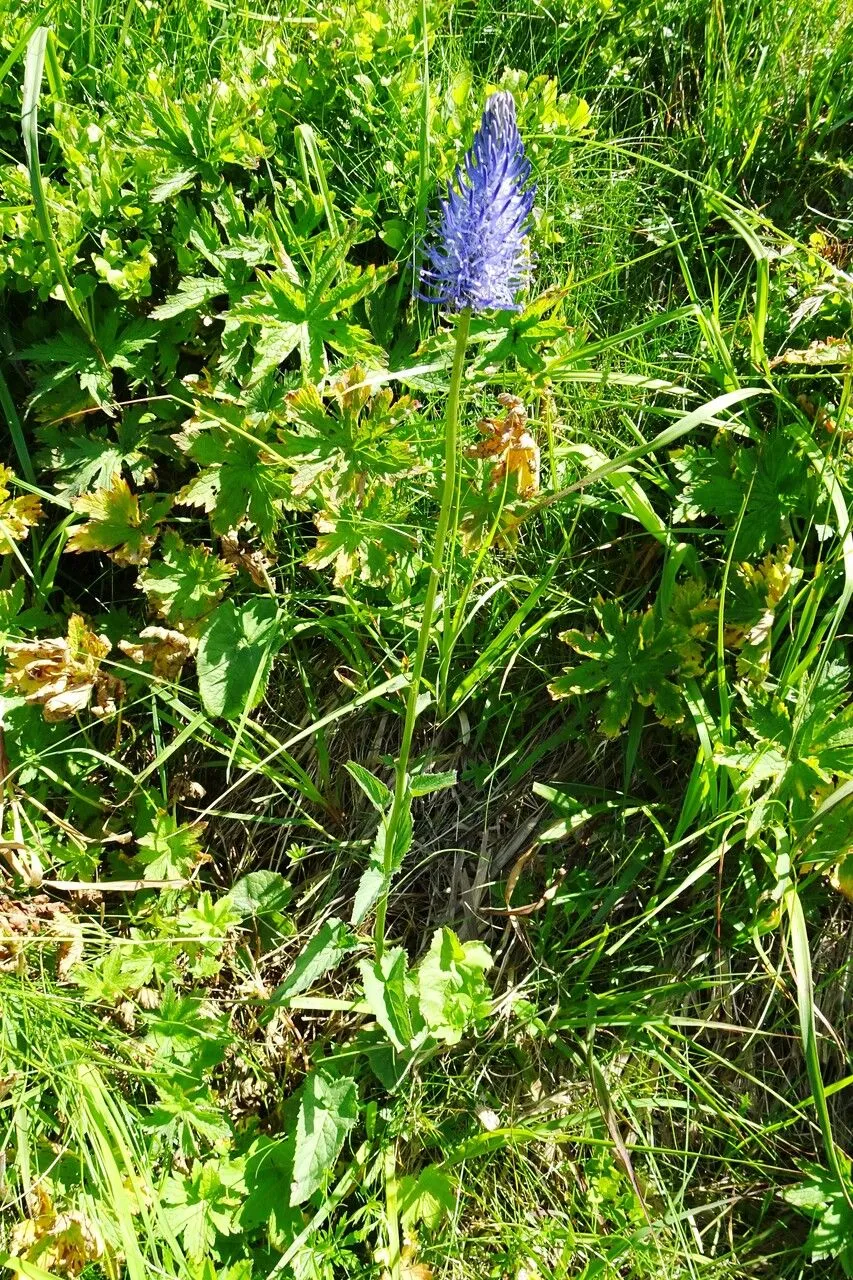
Author: L.
Bibliography: Sp. Pl.: 171 (1753)
Year: 1753
Status: accepted
Rank: species
Genus: Phyteuma
Vegetable: False
Observations: Europe
The spiked rampion, scientifically known as Phyteuma spicatum, is a notable plant species within the Campanulaceae family. This elegant flowering plant is native to Europe, where it thrives in diverse habitats, often gracing meadows, woodlands, and mountainous regions with its striking appearance.
Characterized by its unique inflorescences, the spiked rampion features elongated, cylindrical flower spikes adorned with numerous small, star-shaped blossoms. These blooms typically display a charming array of colors, ranging from pristine whites to soft blues and purples. The flowers of Phyteuma spicatum exude a subtle yet captivating allure that contributes to the biodiversity and aesthetic value of their natural habitats.
First documented in 1753 by the eminent botanist Carl Linnaeus in his expansive work “Species Plantarum,” this plant has since been a subject of interest for botanists and plant enthusiasts alike. The spiked rampion’s distinct floral morphology and ecological importance make it worthy of study and appreciation.
In terms of its ecological role, spiked rampion plays a significant part in supporting pollinator populations. Its blossoms attract a variety of insects, including bees and butterflies, which in turn aid in the plant’s reproductive processes through pollination. This interaction underscores the plant’s importance within its ecosystem, contributing to the maintenance of healthy biodiversity.
Cultivating Phyteuma spicatum in gardens or conservation areas can be an excellent way to preserve this beautiful species while enhancing the visual appeal of natural and landscaped environments. Gardeners and conservationists value its hardiness and its ability to adapt to different soil types and conditions, making it a versatile addition to plant collections aiming to reflect the diversity of European flora.
Overall, the spiked rampion, with its striking aesthetics and ecological significance, remains a captivating subject in the study of European plant life and an enduring testament to the rich botanical heritage documented since the 18th century.
Dan: aks-rapunsel, almindelig honningurt, blå øjeblomst, gul daglilje
Swe: blå bägarkrokus, honungsfacelia, prins gustafs öga, gul daglilja, vaaleatähkämunkki, vitrapunkel
Fin: vaaleatähkämunkki
Nno: vadderot
Nob: vadderot
Nld: zwartblauwe rapunzel en witte rapunzel, witte rapunzel
Deu: ähren-teufelskralle, ährige teufelskralle
Eng: spiked rampion
Cym: cyrnogyn pigfain
En: Spiked Rampion
Cs: Zvonečník klasnatý
Da: Aks-rapunsel, Almindelig honningurt, Blå øjeblomst, Gul daglilje
Nl: Zwartblauwe rapunzel en witte rapunzel, Witte rapunzel
Fi: Vaaleatähkämunkki
Fr: Raiponce en épi
De: Ähren-Teufelskralle, Ährige Teufelskralle, Ährige Rapunzel, Lange Teufelskralle
It: Raponzolo giallo
Nb: Vadderot
Nn: Vadderot
Sk: Zerva klasnatá
Sv: Blå bägarkrokus, Honungsfacelia, Prins Gustafs öga, Gul daglilja, Vaaleatähkämunkki, Vitrapunkel
Cy: Cyrnogyn Pigfain
: Spiked rampion
© copyright of the Board of Trustees of the Royal Botanic Gardens, Kew.
© copyright of the Board of Trustees of the Royal Botanic Gardens, Kew.
© copyright of the Board of Trustees of the Royal Botanic Gardens, Kew.
Taken Jun 21, 2020 by virginie boubee (cc-by-sa)
Taken May 3, 2020 by beurny (cc-by-sa)
Taken Jul 20, 2021 by Alain Bigou (cc-by-sa)
Taken May 31, 2002 by Wolfgang Fiege (cc-by-sa)
Taken May 31, 2020 by Eddy Oldy (cc-by-sa)
Taken Jul 20, 2021 by Alain Bigou (cc-by-sa)
Taken Jun 9, 2021 by Jäger Latein (cc-by-sa)
Taken Jun 3, 2021 by Torsten Dudda (cc-by-sa)
Taken May 29, 2017 by Sylvain Kohli (cc-by-sa)
Taken May 3, 2020 by beurny (cc-by-sa)
Taken Jul 20, 2021 by Alain Bigou (cc-by-sa)
Taken Jun 10, 2020 by Alain Bigou (cc-by-sa)
Taken Jun 21, 2020 by virginie boubee (cc-by-sa)
Taken Jun 23, 2020 by Alain Bigou (cc-by-sa)
Taken Jun 19, 2021 by Pierre LEON (cc-by-sa)
Taken Jun 22, 2020 by Martin Poljak (cc-by-sa)
Taken Apr 29, 2017 by Yoan MARTIN (cc-by-sa)
Taken May 20, 2013 by Tela Botanica − Yoan MARTIN (cc-by-sa)
Taken May 14, 2015 by Tela Botanica − Paul FABRE (cc-by-sa)
Taken May 3, 2020 by beurny (cc-by-sa)
Taken Aug 11, 2015 by Tela Botanica − Liliane ROUBAUDI (cc-by-sa)
Taken Apr 17, 2014 by Tela Botanica − Mathilde DUVERGER (cc-by-sa)
Taken Jun 4, 2017 by Tela Botanica − Liliane ROUBAUDI (cc-by-sa)
Taken Jun 4, 2017 by Tela Botanica − Liliane ROUBAUDI (cc-by-sa)
Taken Aug 11, 2015 by Tela Botanica − Liliane ROUBAUDI (cc-by-sa)
Taken May 21, 2022 by Rico Mende (cc-by-sa)
Taken Aug 2, 2021 by Pietro Brignoli (cc-by-sa)
Taken Apr 19, 2020 by ByteCruncher (cc-by-sa)
Taken Jun 12, 2014 by Tela Botanica − Françoise CARLE (cc-by-sa)
Taken Jun 17, 2022 by Waldemar Zeja (cc-by-sa)
Ph maximum: 7.0
Ph minimum: 6.5
Light: 5
Atmospheric humidity: 5
Soil nutriments: 5
Family: Myrtaceae Author: (F.Muell.) K.D.Hill & L.A.S.Johnson Bibliography: Telopea 6: 402 (1995) Year: 1995 Status:…
Family: Rubiaceae Author: Pierre ex A.Froehner Bibliography: Notizbl. Bot. Gart. Berlin-Dahlem 1: 237 (1897) Year:…
Family: Sapindaceae Author: Koidz. Bibliography: J. Coll. Sci. Imp. Univ. Tokyo 32(1): 38 (1911) Year:…
Family: Asteraceae Author: A.Gray Bibliography: Pacif. Railr. Rep.: 107 (1857) Year: 1857 Status: accepted Rank:…
Family: Fabaceae Author: Medik. Bibliography: Vorles. Churpfälz. Phys.-Ökon. Ges. 2: 398 (1787) Year: 1787 Status:…
Family: Aspleniaceae Author: (Cav.) Alston Bibliography: Bull. Misc. Inform. Kew 1932: 309 (1932) Year: 1932…